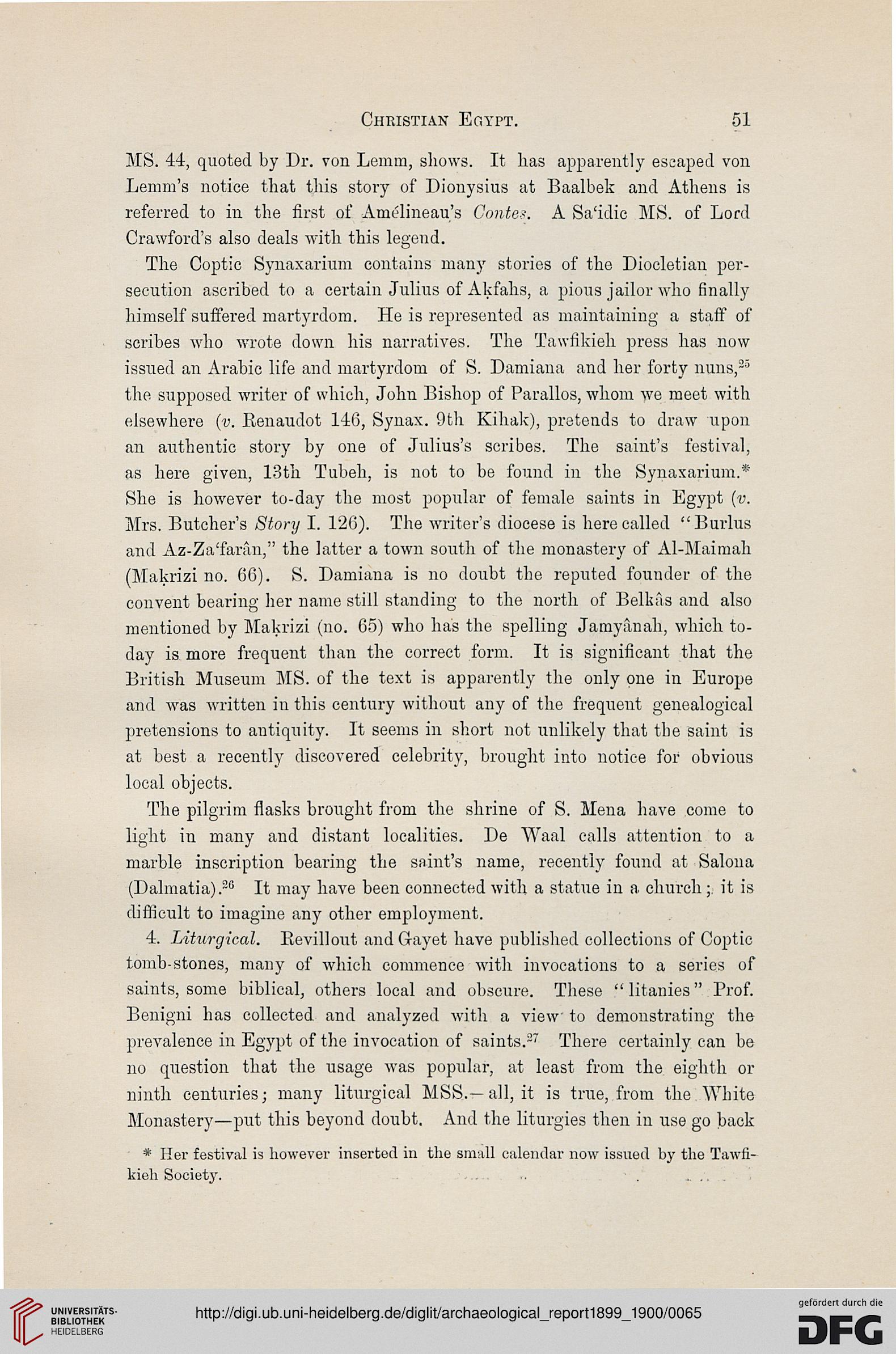Christian Ecjypt.
51
MS. 44, quoted by Dr. von Lemm, shows. It has apparently escaped von
Lemm's notice that this story of Dionysius at Baalbek and Athens is
referred to in the first of Amelineau's Contes. A Sa'idic MS. of Lord
Crawford's also deals with this legend.
The Coptic Synaxarium contains many stories of the Diocletian per-
secution ascribed to a certain Julius of Akfahs, a pious jailor who finally
himself suffered martyrdom. He is represented as maintaining a staff of
scribes who wrote down his narratives. The Tawfikieh press has now
issued an Arabic life and martyrdom of S. Damiana and her forty nuns,25
the supposed writer of which, John Bishop of Parallos, whom we meet with
elsewhere (v. Benaudot 146, Synax. 9th Kihak), pretends to draw upon
an authentic story by one of Julius's scribes. The saint's festival,
as here given, 13th Tubeh, is not to be found in the Synaxarium.*
She is however to-day the most popular of female saints in Egypt (v.
Mrs. Butcher's Story I. 12G). The writer's diocese is here called "Burlus
and Az-Za'faran," the latter a town south of the monastery of Al-Maimah
(Makrizi no. 66). S. Damiana is no doubt the reputed founder of the
convent bearing her name still standing to the north of Bellsas and also
mentioned by Makrizi (no. 65) who has the spelling Jamyanah, which to-
day is more frequent than the correct form. It is significant that the
British Museum MS. of the text is apparently the only one in Europe
and was written in this century without any of the frequent genealogical
pretensions to antiquity. It seems in short not unlikely that the saint is
at best a recently discovered celebrity, brought into notice for obvious
local objects.
The pilgrim flasks brought from the shrine of S. Mena have come to
light in many and distant localities. De Waal calls attention to a
marble inscription bearing the saint's name, recently found at Salona
(Dalmatia).20 It may have been connected with a statue in a church; it is
difficult to imagine any other employment.
4. Liturgical. Bevillout and Gayet have published collections of Coptic
tomb-stones, many of which commence with invocations to a series of
saints, some biblical, others local and obscure. These "litanies" Prof.
Benigni has collected and analyzed with a view to demonstrating the
prevalence in Egypt of the invocation of saints.27 There certainly can be
no question that the usage was popular, at least from the eighth or
ninth centuries; many liturgical MSS.— all, it is true, from the White
Monastery—put this beyond doubt. And the liturgies then in use go back
* Her festival is however inserted in the small calendar now issued by the Tawfi-
kieh Society. ....... . ....
51
MS. 44, quoted by Dr. von Lemm, shows. It has apparently escaped von
Lemm's notice that this story of Dionysius at Baalbek and Athens is
referred to in the first of Amelineau's Contes. A Sa'idic MS. of Lord
Crawford's also deals with this legend.
The Coptic Synaxarium contains many stories of the Diocletian per-
secution ascribed to a certain Julius of Akfahs, a pious jailor who finally
himself suffered martyrdom. He is represented as maintaining a staff of
scribes who wrote down his narratives. The Tawfikieh press has now
issued an Arabic life and martyrdom of S. Damiana and her forty nuns,25
the supposed writer of which, John Bishop of Parallos, whom we meet with
elsewhere (v. Benaudot 146, Synax. 9th Kihak), pretends to draw upon
an authentic story by one of Julius's scribes. The saint's festival,
as here given, 13th Tubeh, is not to be found in the Synaxarium.*
She is however to-day the most popular of female saints in Egypt (v.
Mrs. Butcher's Story I. 12G). The writer's diocese is here called "Burlus
and Az-Za'faran," the latter a town south of the monastery of Al-Maimah
(Makrizi no. 66). S. Damiana is no doubt the reputed founder of the
convent bearing her name still standing to the north of Bellsas and also
mentioned by Makrizi (no. 65) who has the spelling Jamyanah, which to-
day is more frequent than the correct form. It is significant that the
British Museum MS. of the text is apparently the only one in Europe
and was written in this century without any of the frequent genealogical
pretensions to antiquity. It seems in short not unlikely that the saint is
at best a recently discovered celebrity, brought into notice for obvious
local objects.
The pilgrim flasks brought from the shrine of S. Mena have come to
light in many and distant localities. De Waal calls attention to a
marble inscription bearing the saint's name, recently found at Salona
(Dalmatia).20 It may have been connected with a statue in a church; it is
difficult to imagine any other employment.
4. Liturgical. Bevillout and Gayet have published collections of Coptic
tomb-stones, many of which commence with invocations to a series of
saints, some biblical, others local and obscure. These "litanies" Prof.
Benigni has collected and analyzed with a view to demonstrating the
prevalence in Egypt of the invocation of saints.27 There certainly can be
no question that the usage was popular, at least from the eighth or
ninth centuries; many liturgical MSS.— all, it is true, from the White
Monastery—put this beyond doubt. And the liturgies then in use go back
* Her festival is however inserted in the small calendar now issued by the Tawfi-
kieh Society. ....... . ....





